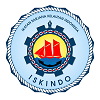Rancang Bangun Alat Ukur Potensi Gelombang Laut Dengan Metode Superposisi Gelombang
Abstract
ABSTRACT
Banyak perangkat maritim, seperti sistem navigasi kapal dan Pembangkit Listrik Tenaga Gelombang Laut (PLTGL), sangat bergantung pada data karakteristik gelombang laut. Beberapa alat ukur karakteristik gelombang laut telah dijual di pasaran, namun tidak terjangkau dan sulit dioperasikan. Penelitian ini bertujuan untuk merancang dan membangun alat ukur ketinggian gelombang laut berbasis pengolahan sinyal menggunakan metode Fast Fourier Transform (FFT) dan prinsip superposisi. Sistem pengukuran menggunakan sensor Inertial Measurement Unit (IMU) yang merekam data percepatan secara real-time. Data tersebut kemudian dianalisis untuk mengekstrak parameter utama gelombang, termasuk tinggi gelombang, frekuensi, dan kecepatan rambat gelombang. Eksperimen dilakukan di fasilitas wave generator selama 5 menit dengan frekuensi pengambilan data sebesar 25 Hz. Hasil eksperimen menunjukkan kondisi gelombang uji pada frekuensi motor 25 Hz mempunyai tinggi gelombang air sebesar 1 cm. Hasil pengukuran dibandingkan dengan pengukuruan/pengamatan visual di kolom wave generator menunjukkan perbedaan pengukuran sebesar 2% dengan frekuensi dominan yang didapatkan berada di 3,2 Hz yang didapatkan dari amplitudo dominan di sinyal domain waktu. Studi ini diharapkan dapat berkontribusi dalam perkembangan teknologi maritim dalam mendukung sektor pelayaran dan energi terbarukan berbasis kelautan di Indonesia.
Kata Kunci: Ketinggian Gelombang, FFT, Gelombang Superposisi, Karakteristik Gelombang, Sensor IMU.
ABSTRAK
Many maritime devices, such as ship navigation systems and Wave Ocean Power Plants, rely heavily on data on ocean wave characteristics. Several water wave characteristic measuring instruments have been sold on the market, but not affordable and difficult to operate. The aim of this study is to design and build a wave height measuring instrument based on signal processing using the Fast Fourier Transform (FFT) method and the superposition wave. The measurement system uses an Inertial Measurement Unit (IMU) sensor that records acceleration data in real time. The data is analyzed to extract the main parameters of the wave, including wave height, frequency, and wave propagation speed. The experiment is conducted at the wave generator facility for 5 minutes with a data collection frequency of 25 Hz. The results of the experiment show that the test wave conditions at a motor frequency of 25 Hz had a water wave height of 1 cm. The measurement results compared with the visual measurement/observation in the wave generator column show a measurement difference of 2%, with the dominant frequency obtained being 3.2 Hz, derived from the dominant amplitude in the time domain signal. This study is expected to contribute to the development of maritime technology in supporting the shipping and marine-based renewable energy sectors in Indonesia.
Keywords: FFT, IMU Sensor, Superposition Wave, Wave Characteristic, Wave Height
Full Text:
PDF (Bahasa Indonesia)References
Abankwa, N. O., Johnston, S. J., Scott, M., & Cox, S. J. (2015). Ship motion measurement using an inertial measurement unit. 2015 IEEE 2nd World Forum on Internet of Things (WF-IoT), 375–380. https://doi.org/10.1109/WF-IoT.2015.7389083
Bagus Widyo Astomo, R., Kurniawati, I., Mahmudah, A., & others. (2023). Rancang Bangun Instrumen Pengukur Tinggi Gelombang Permukaan Laut Menggunakan Sensor IMU GY955. Rancang Bangun Instrumen Pengukur Tinggi Gelombang Permukaan Laut Menggunakan Sensor IMU GY955, 4(1), 26–36. https://doi.org/10.31328/jasee.v4i01.277
Belega, D., & Petri, D. (2021). Fast procedures for accurate parameter estimation of sine-waves affected by noise and harmonic distortion. Digital Signal Processing, 114, 103035. https://doi.org/10.1016/j.dsp.2021.103035
Benbouzid, M., Amirat, Y., & Elbouchikhi, E. (2020). Marine tidal and wave energy converters: Technologies, conversions, grid interface, fault detection, and fault-tolerant control. MDPI.
Benetazzo, A., Fedele, F., Gallego, G., Shih, P. C., & Yezzi, A. (2012). Offshore stereo measurements of gravity waves. Coastal Engineering, 64, 127–138. https://doi.org/10.1016/j.coastaleng.2012.01.007
Bentley, J. P. (2005). Principles of measurement systems. Pearson education.
Christou, M., & Ewans, K. (2014). Field measurements of rogue water waves. Journal of Physical Oceanography, 44(9), 2317–2335. https://doi.org/10.1175/JPO-D-13-0199.1
Djatmiko, E. (2019). Perilaku dan Operabilitas Bangunan Laut di Atas Gelombang Acak.
Dolcetti, G., Krynkin, A., Alkmim, M., Cuenca, J., De Ryck, L., Sailor, G., Muraro, F., Tait, S. J., & Horoshenkov, K. V. (2024). Reconstruction of the Frequency-Wavenumber Spectrum of Water Waves With an Airborne Acoustic Doppler Array for Noncontact River Monitoring. IEEE Transactions on Geoscience and Remote Sensing, 62, 1–14. https://doi.org/10.1109/TGRS.2024.3358672
Greaves, Deborah., & Iglesias, Gregorio. (2018). Wave and tidal energy. John Wiley & Sons Ltd. https://doi.org/10.1002/9781119014492
Hereman, W. (2013). Shallow Water Waves and Solitary Waves. http://arxiv.org/abs/1308.5383
Holthuijsen, L. H. (2010). Waves in oceanic and coastal waters. Cambridge university press.
Khedkar, K., Nangia, N., Thirumalaisamy, R., & Bhalla, A. P. S. (2020). The inertial sea wave energy converter (ISWEC) technology: Device-physics, multiphase modeling and simulations. ArXiv Preprint ArXiv:2005.06108. https://doi.org/10.1016/j.oceaneng.2021.108879
Kurnia, M. H., Saputra, R. E., & Setianingsih, C. (2021). High-Low Detection of Sea Water Waves With Multi-Sensor System Based on Iot. E-Proceeding Eng, 8(5), 6175–6182.
Li, J., Qian, Z. W., Hong, D. Y., & Zhai, J. S. (2024). Precise and low-complexity method for underwater Doppler estimation based on acoustic frequency comb waveforms. Frontiers in Marine Science, 11. https://doi.org/10.3389/fmars.2024.1365095
Liu, Y., Wang, X., You, J., & Chen, C. (2020). Ocean Wave Buoy Based on Parallel Six-Dimensional Accelerometer. IEEE Access, 8, 29627–29638. https://doi.org/10.1109/ACCESS.2020.2971711
Mai, T. L., Vo, A. K., Cho, A., Yoon, H. K., & others. (2024). Experimental investigation on wave characteristics due to interference of catamaran demi-hulls in waves. International Journal Of Naval Architecture And Ocean Engineering, 16, 100594. https://doi.org/10.1016/j.ijnaoe.2024.100594
Mayon, R., Ning, D., Ding, B., & Sergiienko, N. Y. (2022). Wave energy converter systems–status and perspectives. In Modelling and Optimization of Wave Energy Converters (pp. 3–58). CRC Press. https://doi.org/10.1201/9781003198956-1
Ning, D., & Ding, B. (2022). Modelling and optimization of wave energy converters. CRC Press. https://doi.org/10.1201/9781003198956
Pandey, J. (2017). Manoeuvring and Guidance of Catamaran Wave Adaptive Modular Vessel.
Patra, S. K., & Jena, B. K. (2014). Inter-comparison of wave measurement by accelerometer and GPS wave buoy in shallow water off Cuddalore, east coast of India.
Samad, A., Sannasiraj, S. A., Sundar, V., & Halder, P. (2021). Ocean wave energy systems: Hydrodynamics, power takeoff and control systems (Vol. 14). Springer Nature. https://doi.org/10.1007/978-3-030-78716-5
Sediono, W. (2013). Method of Measuring Doppler Shift of Moving Targets Using FMCW Maritime Radar. https://doi.org/10.1109/TALE.2013.6654465
Tian, L. (2014). Ocean wave simulation by the mix of FFT and Perlin Noise.
Voelz, D. G. (2011). Computational fourier optics: a MATLAB tutorial. (No Title), 51. https://doi.org/10.1117/3.858456
DOI: https://doi.org/10.21107/jk.v18i2.30124
Refbacks
- There are currently no refbacks.

This work is licensed under a Creative Commons Attribution 4.0 International License.

Jurnal Kelautan by Program Studi Ilmu Kelautan is licensed under a Creative Commons Attribution 4.0 International License.
Published by: Department of Marine Sciences, Trunojoyo University of Madura













